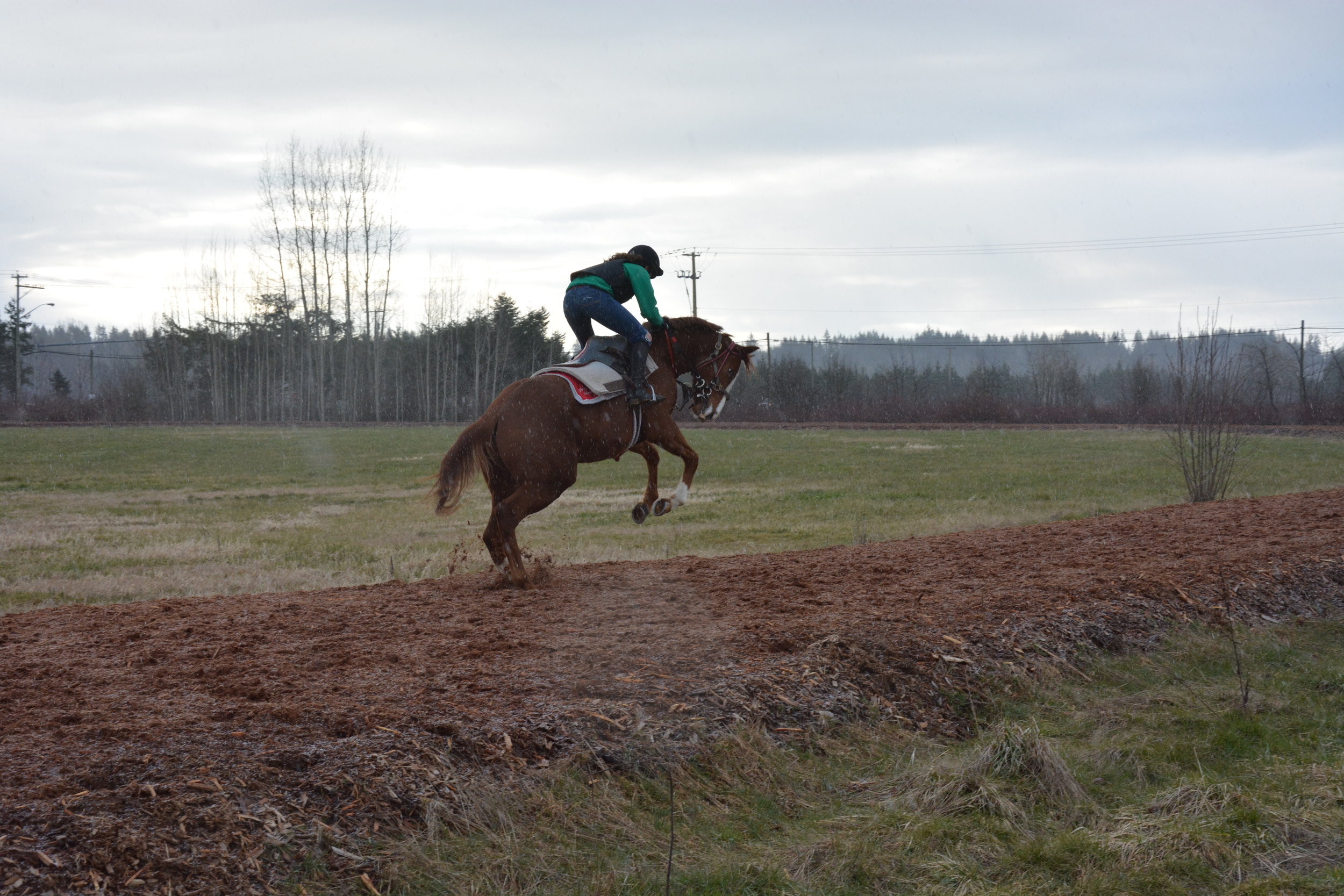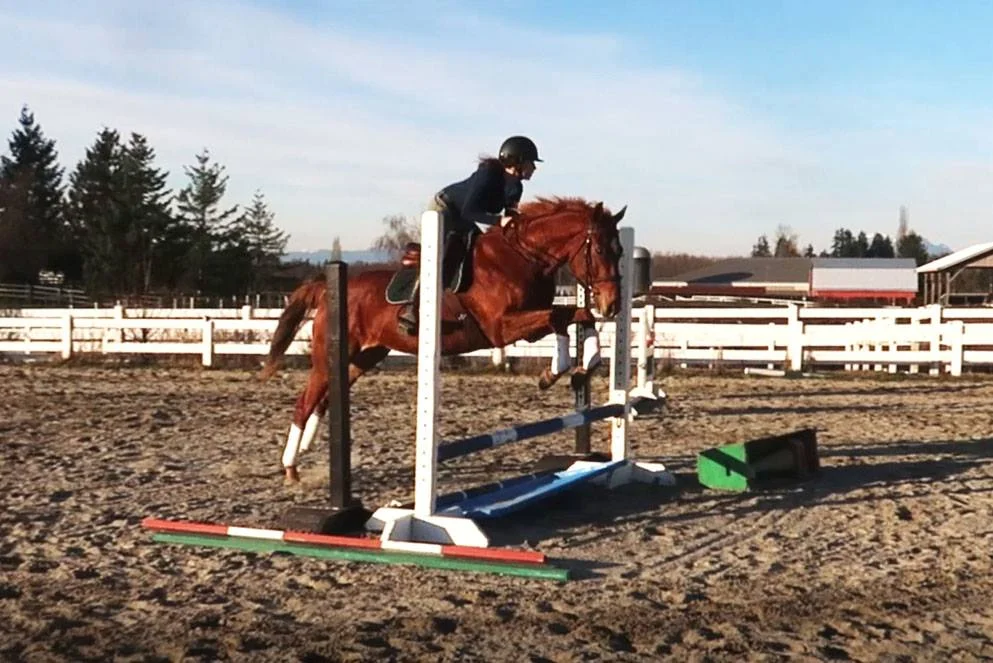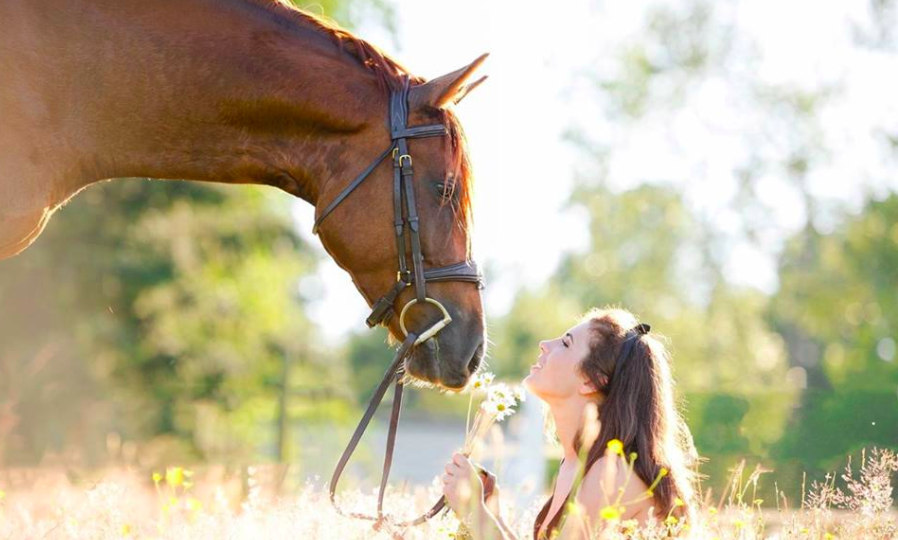This is a paper I did for an Equine Behaviour class through Guelph University, hope you enjoy!
Imprinting is the idea that there is a special category of learning during a very sensitive period early on in an animal’s development, most commonly thought of in reference to birds when they learn to follow a “mother figure”. The idea of imprinting in horses was originally introduced by Dr. Robert Miller, who used the term to describe the behaviour of young foals during a sensitive period when the “following response” is first learned, which happens within the first two days of life (McGreevy, 2012). During this time the dam is usually the nearest animal to the foal and to whom the foal will bond with most strongly.
Imprinting is first brought about by sense of sight, but sound and smell also play a role. Miller used his findings on imprinting in horses to coin the term “imprint training” and to introduce a new methodology to change the behaviour of newborn foals. His philosophy attempts to reduce the likelihood of foals developing aversive behaviours and aggression-based defense mechanisms towards humans while allowing the horse to become sensitive to the very popular pressure and release methods used in most forms of horse training.
Miller’s recommendations to appropriately imprint train a foal are very hands-on and involve a lengthy process in which the handler is required to habituate the foal to common stimuli as well as to sensitize the foal to important stimuli such as the pressure and release associated with leading with a halter. Miller’s method involves 30-50 different interactions, which Miller refers to as “stimulations” of the foal, of each region of the foal’s body (McGreevy, 2012). During the foal’s first hour of life, imprinting will begin with drying the foal immediately after birth and cutting the umbilical cord. Within the first day of life, habituation starts with the foal learning how to tolerate being held securely by a human while it stands; this process will continue until the foal learns to stop fighting and relaxes. After this step, the foal is touched all over its body in a rubbing motion until it becomes acclimated and relaxes as a result. This process begins with the ears (which includes the inner canals), face, lips and mouth/tongue and nostrils before spreading to the eyes, neck, abdomen, back, legs feet, rump and tail area and finishing with the perineum and external genital areas (McGreevy, 2012). After the rubbing process, imprint training calls for introducing the horse to aversive stimuli such as clippers, rectal thermometers and “practice” rectal exams. These stimuli are continuously introduced until the foal relaxes, seemingly amounting to flooding. The habituation for the foal to unusual objects moves onto the handler uses a piece of crackling plastic or tarp to rub over the foal’s entire body until the foal ceases to panic. Miller’s program also calls to habituate the foal to sounds such as gunfire, sprayers, whistles, loud music, flapping flags and swinging ropes (McGreevy, 2012). To prepare for the sensation of a girth when riding, habituation to girth area calls for the handler to encircle the foal’s girth area with their arms and squeeze at rhythmic intervals until the foal learns to stop resisting the sensation. Following the habituation process is the sensation process of imprint training. This is where the foal is taught to learn pressure and release for leading in a halter, which is also a process seen in other forms of training using negative reinforcement and is not exclusive to Miller’s method of imprint training. This includes applying pressure until the foal succumbs to it and moves off the pressure, then releasing the pressure. This form of training is widely used for horses in hand and under saddle.
While some of Miller’s method is justifiable for enhancing mare and foal safety, such as teaching the foal to respond to pressure from a halter and lead appropriately at a young age, much of what Miller recommends to “imprint” the foal excessively hands on when keeping the age of the foal in mind. Studies have shown that foals separated from their dams even just for an hour generally go on to show patterns of strong dependence on their dams along with little play, social withdrawal and aggressive tendencies (Henry et al, 2009). This is of concern due to the need for persistence in physical restraint of the foal in Miller’s method. It is also important to keep in mind that physically restraining a foal can increase its risk of injury, due to the struggling and fighting that is sure to ensue if it is kept away from its dam and become panicked from being restrained. Another issue with Miller’s program is that there lacks sufficient evidence to show that waiting until the foal is older won’t produce similar results in terms of habituation and learning to cope with aversive stimuli. The exact occurrence of the sensitive period for learning in foals still remains to be found, however, some studies have concluded that handling throughout the first 42 days of life improved foals’ performance in halter-training tasks when compared with handling from 43 to 84 days of life (Mal & McCall, 1996). This suggests that the sensitive period of learning may occur within the first 42 days of life. Other studies have indicated that when foals are only moderately handled up until a year and a half of age, they showed greater problem solving skills than extensively handled horses (Heird et al, 1986). This same study also found that extensively handled horses showed to be less emotional, showed higher maze learning performance and were more trainable for riding than the less handled horses. Studies such as this show that there is evidence to necessitate early handling in foals with regards to habituation to reduce flight response, but this does not necessarily require an invasive method such as Miller’s imprint training. Recent studies show that imprint training doesn’t correspond with any natural communications or patterns in equine behaviour and often times foals are very distressed and strongly resist these methods (McGreevy, 2012). There has also been no beneficial effect to be found on the behaviour and trainability of foals later in life when tested on foals handled at 12, 24 and 48 hours after birth compared to their behaviour at 1,2, 3 and 6 months of age. This alone displays that Miller’s method is far too invasive when keeping in mind the pros and cons of training. It may be easier for the handler to introduce a foal to certain stimuli when it is younger, smaller and not as strong but as a handler of horses it is important to keep the best interest of the animal in mind when choosing how to work with it, and Miller’s method calls for some questionably invasive tactics that can be traumatic and very distressing for such a young animal. Specifically, introducing the foal to stimuli such as clippers and rectal exams should definitively be left until later in life. Certain aspects of Miller’s imprint training method are beneficial in terms of teaching foals to learn to tolerate necessary handling such as picking up feet or being comfortable enough around humans to readily approach them; early handled foals demonstrated both of these things more readily than unhandled foals. It is important to keep in mind that teaching a foal to pick up feet or be comfortable around humans is a lot less hands on than what most of Miller’s method calls for. Most of the positive learning can be done without flooding the foal with so much aversive stimuli at such a young age, especially when keeping in mind that studies have found that aversive stimuli were not found to be more tolerable from imprint training, as demonstrated when comparing foals who had been imprinted to those who hadn’t when fitting halters and clipping at 3 or 4 months of age (McGreevy, 2012). Similar studies have also shown that neonatal handling of foals only reaps short term benefits and after a year, the handled foals tolerated handling (haltering, picking feet, being touched all over) equally as well as the unhandled foals. Along with this, handling did not appear to have any effect on the reactivity at foals at any time during the study, meaning that even imprinted foals had the same level of reactivity to aversive stimuli as the unhandled foals. Imprinted foals also did not show any heightened spatial or discriminative learning capabilities and the study concluded the benefits of early handling to be temporary (Lansade et al, 2004). Further scientific evidence in another study performed by Texas A&M University showed that neither the frequency nor the duration of imprint training sessions influenced the foal’s behaviour after six months of age and in this particular study, imprint training showed no evidence of better behaved or less reactive foals.
While more research still needs to be done on the handling of foals and the best way to produce a trainable athlete who is well adapted to humans, the studies that are available on imprint training unanimously conclude that there are either no benefits found or only negligible temporary benefits. In addition, there are a variety of studies that bring up concerning behaviours and potential issues that can arise because of the very invasive handling imprint training calls for in neonatal foals. As a result, it is worrisome that imprint training is being marketed as a great way to handle young horses and to create willing, well behaved athletes. Based off the findings of behavioural science, imprint training should not be considered by handlers as a way to create a well-adjusted foal, due to the importance of the mother-foal bond and the stress resulting from overly invasive handling that can cause behavioural problems later on in life, including but not limited to, aggression. While some of the basic aspects of imprint training may be beneficial in terms of safety for mare and foal, the vast majority of the handling Miller’s method calls for is overly invasive and unnecessary. Introducing aversive stimuli such as clippers and faux rectal exams are training procedures that do not need to occur with a neonatal foal and doing such is very likely to cause undue stress for such an immature animal. Given the fact that the purpose of imprint training is to create less reactive, more manageable and easier to handle horses, the fact that studies have shown that unhandled horses show the same levels of reactivity as imprinted foals did after 6 months of age is substantial evidence to disprove the entire mindset behind imprint training. This coupled with the presence of undesirable behaviours found to be associated with any potential distress caused from introduce such young foals to aversive stimuli and separating them from their dams for any amount of time for training should make it clear to horse handlers that there are better ways to create well-behaved horses. Another issue with imprint training is the potential for flooding to occur, which could be incredibly overwhelming for a young foal. In some cases, flooding can result in tonic immobility which is an animal’s last attempt at survival during perceived danger. During this phenomenon, the body goes into a state of paralysis, which could easily be interpreted as submission and relaxation in Miller’s method, since imprint training calls for the continuous introduction of stimuli until the foal accepts it and relaxes (Randle, 2015).
In lieu of opting for Miller’s complete imprint training method, handlers could choose to take certain aspects of it (which are largely seen in other methods and not necessarily specific to imprint training) such as introducing a halter and basic pressure and release training at a younger age and under the close supervision of the dam. This type of handling can come in handy for emergencies in which the foal may need to be moved quickly and halter training along with knowing how to pick up feet may improve the safety of both the foal and dam. Along with this, those who are breeding should be conscious to develop a close and comfortable relationship with the dam as studies have shown that this can influence the foal’s behaviour and reactivity around humans. This is an incredibly easy and non-invasive way to help encourage neonatal foals to be trusting and compliant around humans and can start prior to them being born (Lesté-Lasserre, 2015). Basic positive reinforcement training, such as offering the foal scratches when they approach humans willingly may also help to improve the foal’s response to humans and human handling while reducing their reactivity to human interference (McGreevy, 2012). Another important factor in handling foals is to ensure that they are allowed to be well socialized and free to practice natural behaviours. Allowing foals to spend time with their dams along with other conspecifics of similar ages will help them to shape important social skills that will in turn better their behaviour as they grow older. This along with adequate turn out and the ability to express other natural behaviours has been shown to improve overall trainability and ease of handling (McGreevy, 2012) and is far less invasive and time consuming for humans than what Miller’s method suggests. Other than that, studies have demonstrated that foals can be largely left unhandled and still be comparable to intensively handled foals when compared at six months of age.
Ultimately, much of Miller’s method is of concern from the standpoint of equine behaviour and the long term benefit versus the short term gain. The potential for unwanted behaviours to develop due to over-handling at a young age far outweighs any temporary benefits this method may offer. Allowing foals to practice natural behaviours alongside their dams and develop social skills through play with their dam and peers while having access to a turnout setting in which they can practice natural behaviours has been shown to be far more beneficial toward the equine ethogram. Handlers should use caution when choosing which handling methods to employ on young foals and should be conscious of what equine behaviourists have found to be the most successful, along with any potential risk factors and behavioural issues that may be found with a given method.
Works Cited
Lansade, L., Bertrand, M., & Bouissou, M. (2005). Effects of neonatal handling on subsequent manageability, reactivity and learning ability of foals. Applied Animal Behaviour Science,92(1-2), 143-158. doi:10.1016/j.applanim.2004.10.014
Lesté-Lasserre, C. (2015, May 28). Study: Dams Shape Foals' Relationships With Humans. Retrieved April 02, 2017, from http://www.thehorse.com/articles/35853/study-dams-shape-foals-relationships-with-humans
McGreevy, P. (2013). Equine behavior: a guide for veterinarians and equine scientists. Edinburgh: Elsevier.
Miller RM (1991) Imprint training of the newborn foal. Western Horseman Inc., Colorado Springs, CO.
Randle, H. (2015, September 24). Learned Helplessness in Horses. Retrieved April 02, 2017, from http://www.thehorse.com/articles/36478/learned-helplessness-in-horses
Rossdale PD (1967) Clinical studies on the newborn thoroughbred foal i. Perinatal behaviour. Brit Vet J 123: 470-481.
Sellnow, L. (1998, January 1). Foal Imprinting. Retrieved April 02, 2017, from http://www.thehorse.com/articles/10405/foal-imprinting
West, C. M. (2006, February 17). Foal Imprinting -- Research Review. Retrieved April 02, 2017, from http://www.thehorse.com/articles/15847/foal-imprinting-research-review
Williams, J. L., Friend, T. H., Collins, M. N., Toscano, M. J., Sisto-Burt, A., & Nevill, C. H. (2010). Effects of imprint training procedure at birth on the reactions of foals at age six months. Equine Veterinary Journal,35(2), 127-132. doi:10.2746/042516403776114126












































